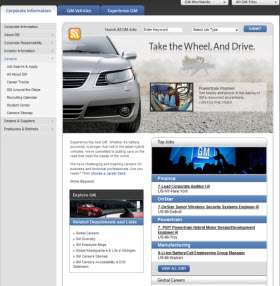What if . . . you were trying to recruit new employees for one of the most famously failing companies in America?
Not a day passes without news of the American auto industry teetering on the brink—and commentators frequently point out that consumers won’t buy cars from a company that’s inches away from bankruptcy. So you have to wonder whether job-seekers might not see Toyota as a better bet than Ford!
On top of that, since Ford, Chrysler and GM are under intense pressure to improve their PR, corporate messaging is now heavy on thriftiness and repentance. Good-bye perks and fat salaries, hello humility! But will the best workers be attracted to a company that apologized in print for being stupid?
Although your company may not be in quite such a fix, odds are that the economic downturn is already having an effect on recruiting, with budgets shrinking and applications increasing. That expanding pool of job-seekers may include high-value employees set adrift by failing companies—but you have to attract them and identify them.
To get an idea of how the auto companies are approaching this problem, I visited the “Careers” pages for Ford, GM, and Toyota. All three offer intro videos, but the videos create very different impressions. At Ford, the video starts automatically, and the message is all about F-A-S-T, with lot of zooms, cuts, and sound effects. The visual focus is mainly on cars—inside, outside, upside down. There is no text message, just instructions for searching the job posts.
Over at GM, on the other hand, the opt-in video feature rotates through clips highlighting diversity, NASCAR, day-on-the-job, etc. The text component is short, but hits the right note with this sentence: “Experience the next GM. Whether it’s battery powered, hydrogen fuel cell or the latest hybrid vehicles, we’re committed to putting cars on the road that meet the needs of the world.” Message? This is the next GM. Not the problem GM you know about now, but the one that’s about to emerge—and you can be part of this rebirth!!
I thought that worked really well under the circumstances, but had to wonder whether the approach was purposeful or just an accident. So I jumped on the Wayback Machine (aka Internet Archive), and found that the GM Career page one year ago featured a diversity snapshot, with this text: “The cars, trucks and SUVs we build are as diverse as the talented individuals who come to work here. And that’s why people from every background continue to choose GM as a great place to build a career and pave the road to a bright future.” Now that’s the voice of a company well pleased with itself . . .
Finally, at Toyota there’s a feel-good video about great cars and great people. No text message, but—and here’s the stroke of genius—a “What’s New” section, featuring press releases on Products, Environment, and Corporate (yes, that’s sales reporting). What does this feature signal? “We’re honest with you.” And we can afford to be honest with you, because the Toyota “news” is not nearly as bad as what’s happening with the Big Three.
Well, it will be interesting to see if there are more changes on these sites. But for now, the takeaway is . . . think seriously about the approach you want to take in this economic environment, and if you haven’t adjusted your site to deliver the most effective message, now might be a good time!
Cynthia Giles has followed a serpentine career path from academia to publishing to marketing and design to information technology and corporate communications. There’s plenty of detail about this journey at www.cynthiagiles.com, but briefly--the common theme has been ideas, and how to present them effectively. Along the way, she became an accidental expert on data warehousing and business intelligence, and for the past ten years she has combined corporate contracting with an independent consulting practice that focuses on marketing strategy for smaller businesses and non-profits.
Having spent quite a bit of time looking for work, and anywhere from two weeks to two years inside a wide variety of American companies—she has given much thought to what works (and what doesn’t) when it comes to creating a great employment fit.

